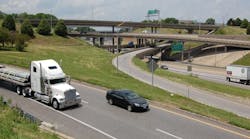Ultimately, innovation is what determines whether companies of all stripes – including those in trucking and logistics – live or die in today’s business world.
And we’re not just talking about innovation solely in terms of cutting-edge technological developments and the like, mind you; innovation in trucking’s case encompasses efforts such as switching to electronic logbooks or moving away from pay-by-the-mile driver wages.
Yet a new survey conducted by consulting firm Accenture finds that U.S. companies continue to struggle with various innovation pursuits – a problem they’ve have been grappling with for the past three years, the firm said.
Accenture’s survey of executives and managers within 500 U.S. companies reveals that six in 10 (60%) said their companies do not learn from past mistakes – nearly double the 36% who admitted to this three years ago when the firm last conducted a similar survey.
Nearly three-fourths (72%) indicate their firm’s often miss opportunities to exploit underdeveloped areas or markets versus 53% three years ago, noted Adi Alon, a managing director with Accenture’s Strategy practice, while more than two-thirds (67%) believe their companies are too risk averse, up from 46% three years ago.“A significant gap exists between what U.S. companies want to achieve in the innovation arena versus what they are able to do,” Alon said in the firm’s report. “They want to innovate yet they need to take different and bolder actions to achieve transformational, major revenue-generating innovation. True innovation requires aggressive changes in technologies, operating models and talent.”
Accenture added that its poll found 82% of the companies surveyed admit they do not distinguish their innovation approaches between incremental versus large-scale transformational change – meaning they use a single “one-size-fits-all” approach to achieve different goals.
“Most respondents said they have ‘big’ innovation ideas but are missing an organizational ‘home’ with the company,” Alon stressed. “So their ideas often go nowhere.”
Still, a large majority of those executives believe innovation remains the key to future success for their companies. For instance, Accenture found 84% believe innovation is key for their long-term success compared with 67% three years ago. The same percentage of respondents – some 84% – said they are looking for the “next silver bullet,” meaning a “market-defining” innovation rather than incremental iterations of the same old thing.
So how do companies successfully jump on the “innovation bandwagon”? Accenture offers several suggestions:
- Build a “two-engine” approach. Companies need to develop “agile innovation operating models” that enables them to test new ideas quickly and absorb new capabilities and talent from other industries. “Engine One” sharply focuses on making existing products and capabilities continually better, while “Engine Two” efforts are disruptive and potentially game-changing. When executed correctly, these innovations deliver a step-change improvement in organizational performance and competitive advantage.
- View innovation through new “lenses.” Despite their best intentions to drive big changes, many companies continue to evaluate and pursue opportunities using the ideas, processes and business models they have relied on for years. In an age where non-traditional entrants are increasingly capturing market share (for trucking, think “Uber for freight” here) while customers are demanding new products, services, conveniences and forms of engagement, a company’s reliance on its “old playbook” will prevent it from achieving competitive advantage.
- Break down industry barriers. Disruptions in everything from the flow of raw materials to the demands of “always on” consumers require a new model based on collaboration (though that sure changes fast when truck capacity increases). Emerging technologies are making it possible for companies to unlock new sources of innovation through alliances across multiple business sectors, while “cross-industry innovation” models lead to competitive differentiation and new sources of growth, revenue and customer loyalty.
It’ll be interesting to see how all of those “innovative” pressures come to bear on trucking in the months ahead.




